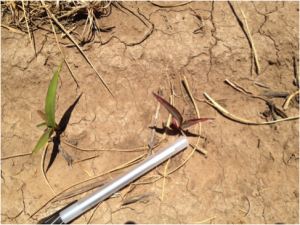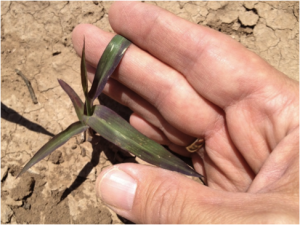Statewide
Occasionally, grain sorghum seedlings growing in early cool conditions, especially if prolonged and coupled with cloudy weather, will demonstrate pronounced purpling of the leaf sheaths and leaf margins/leaf blades (see below). This may be coupled with interveinal yellow striping (chlorosis) related to iron deficiency. The purple color occurs from the accumulation of anthocyanin in the tissue and results from insufficient phosphorous uptake or from the plant’s inability to move sugars from the leaf blade (“Sorghum Growth & Development, Texas A&M AgriLife Extension, B-6137). Symptoms usually disappear when favorable temperatures return.
These conditions can occur throughout Texas whether you are planting in early March in the Coastal Bend or in early May in the High Plains. You have not done anything wrong with P nutrition for your sorghum crop. The seedling in the left picture is at leaf stage 4 and has only recently developed sufficient roots to drive the growth and acquire P beyond what may have been available in seed reserves.
 If you find a field with the purpling color and you have had cool conditions, it is advisable to re-check the field ever few days as warm weather resumes to track the return to normal colored tissue. Look for the newly emerging leaf to be green in color. As long as the plants are otherwise healthy yield potential is generally not compromised though it is possible individual plants might appear stunted.
If you find a field with the purpling color and you have had cool conditions, it is advisable to re-check the field ever few days as warm weather resumes to track the return to normal colored tissue. Look for the newly emerging leaf to be green in color. As long as the plants are otherwise healthy yield potential is generally not compromised though it is possible individual plants might appear stunted.
Could this be herbicide injury? In some cases when pre-emergent chloroacetamide herbicides (Dual, Lasso, Frontier) were applied, rain or irrigation may the chemical into the root zone. Under cool conditions the plants absorb more chemical, and some purpling may occur. Like the above scenario, the return of warm conditions and good growing conditions will diminish the symptoms and injury potential.
How does cool-induced purpling compare to conventional P deficiency? P-deficient sorghum plants are stunted, spindly, and dark green with overtones of dark red on the leaves. The red pigment first appears on older leaves and characteristically progresses upward toward younger leaves. Interveinal (between veins) tissue is sometimes red separated by green veins. On individual leaves redness first appears on the leaf tip and margins then progresses toward the base and midrib of the leaf.









